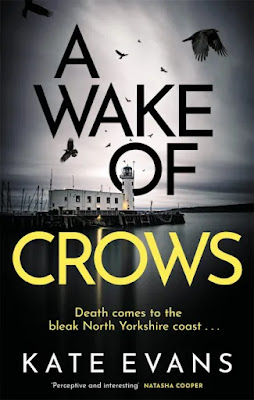This novel is the first of a crime series set in Scarborough. The main character is DC Donna Morris, a woman with a lot on her plate. Not only is Donna starting a new job in a new town, she is living away from her husband and seems conflicted about whether this is a good thing or bad. She is older than most of her colleagues and is experiencing the menopause. Her daughter is in prison (in the fictional HMP North Yorkshire) and this is why Donna has chosen to move to Scarborough, to undertake part of her probationary period as Detective Constable. There would be enough to explore here without a complex murder mystery to solve, but we get one of those too; a former GCHQ employee is found dead in the woods and there are several avenues of enquiry to explore, each very different and involving characters from a wide range of backgrounds, but all from Scarborough!
Having a female main character immediately sets this crime novel apart from so many others, but the writing style differentiates it to an even greater extent. The writing often has a poetic quality. There are many lines I could quote as an example of this, and I wish I had written them down whilst I was reading, but the following is taken from the final page:
The porcelain cup is tipping in the other direction, the sea is drifting away from the land, leaving the tea-leaf-coloured sand to encrust its edge as if waiting for the divining of a new future.
These are the kind of sentences that one might expect to find in literary fiction rather than crime fiction, but I'm certainly not complaining, I can't see why it can't be both. It's not just the word choices and sentence construction that sets the writing apart, it's the empathy for characters. Often in crime fiction, suspects and witnesses are portrayed as being obstructive and unhelpful and whilst some certainly are in A Wake of Crows, Evans considers these characters as humans rather than obstacles. An example of this is with the rough sleepers; Donna goes beyond what some of her colleagues would do in her dealings with these people and there is a chapter where she won't leave Hull until she has tried everything she can think of to help a man who has provided her with some evidence. Donna also recognises the need to be kind to herself.
There are some nice passages where Donna goes for walks to take in the sea air. These provide wonderful descriptions of Scarborough and also a bit of a break from the action, which I welcomed given how busy this novel gets. I like the way that the reader is given the opportunity for respite when Donna decides she needs it. I think this helps to make the reader care more for the main character and also serves as a reminder that we have to take care of ourselves. I found it rather refreshing that, for the most part, DC Morris favours herbal teas over coffee and she doesn't rely on alcohol for comfort or inspiration.
One criticism I have is that there seems to be a lack of urgency to solve the case. The investigation is certainly intriguing, but because it involves GCHQ the reader might be led to wonder if the truth will ever be discovered. In addition to the case though, there are chapters set in East Germany that, we can only assume, must relate to either the case or Donna, or both. It is perhaps these chapters that provide the page-turning quality that is expected from crime fiction.
The way that the present is distinguished from the past in chapter headings is by switching from 'Now' to 'Thirty x' years ago. Slightly confusingly, Now is 2013 and I had to keep remembering that when the chapter says 'Now', it is actually 2013 and then for the chapters that are over thirty years ago, that is based on 2013 being the present. The chapters set in the past actually range from thirty six years ago to thirty three years ago and they move forward through those three years. I think it would have made more sense to label chapters by the year i.e. 2013 and 1977 (to 1980).
Some crime series seem to have the main character do all the work, but DC Morris is definitely part of a team and there is a good selection of distinguishable characters, including DI Theo Akande, DC Trevor Trench and DC Brian Chesters. One character that I found hard to picture was DS Harrie Shilling and I would have liked a bit more description of her considering that she is mentioned quite a lot. Perhaps this will come in future instalments. I sensed the comedic potential with Trevor Trench, but it never really materialised. There isn't much humour in this novel and I don't think it's a criticism to point that out, but I personally would have liked a few quips, particular at Chesters' expense.
One last thing I'd like to point out, because it is something I don't think I have seen before, is the way that italics are used. The novel is written as a close third person narration, sticking mainly with Donna in the present and Erika in the past, but italics are used to show Donna's thoughts in the first person. I thought this was a nice little trick that complements the poetic writing style.
The second book in the series, Drowning Not Waving, is out now in hardback. I very much look forward to reading it.

Comments
Post a Comment